Spring 2025 Contemporary Art Final IDs - Lauren Antonacci
1/15
There's no tags or description
Looks like no tags are added yet.
Name | Mastery | Learn | Test | Matching | Spaced |
|---|
No study sessions yet.
16 Terms
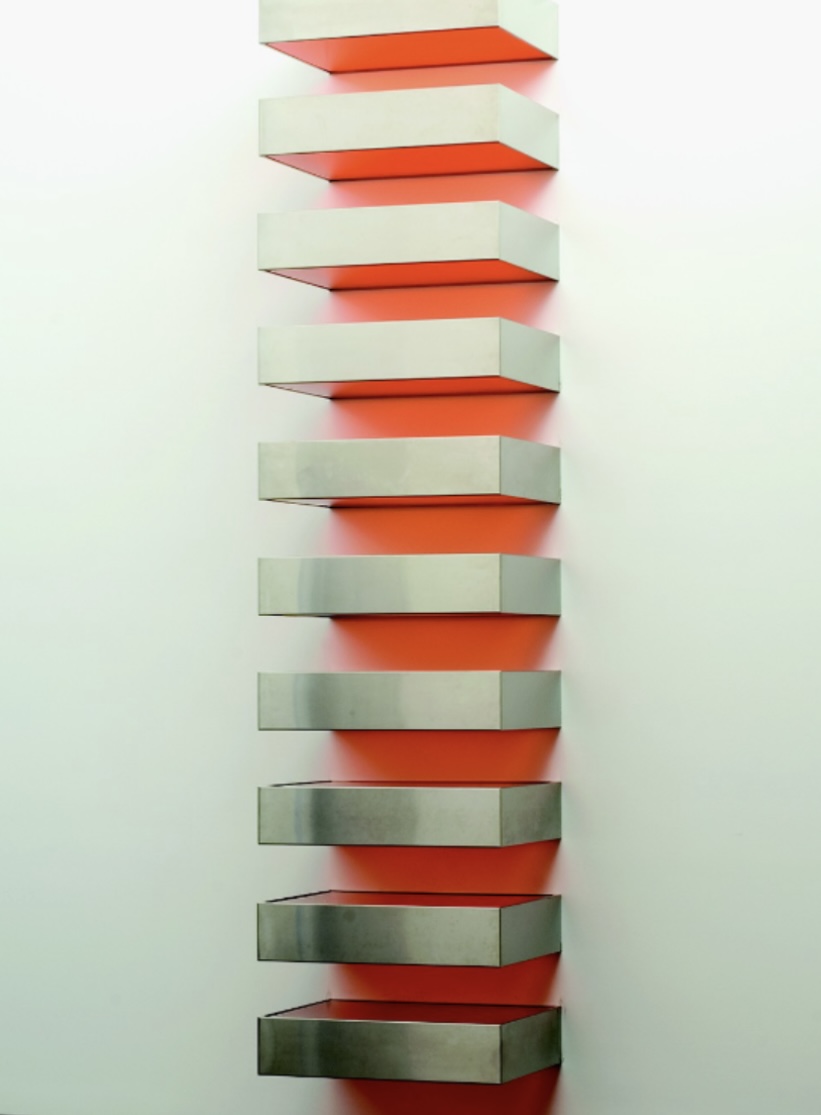
Donald Judd
Untitled (Large Stack)
1965
Galvanized iron, seven boxes
MINIMALISM:
Describes a stripped down style popular in NYC around the 1960s. Characterized by 3D artworks comprising of simple, geometric, industrial forms presented as unitary objects arrange in symmetrical compositions.
Minimalist’s refused using the world “sculpture”- which emphasized the differences between their art and traditional carved, modeled, handmade sculptures - they wanted to ERASE the artist’s hand from their creation.
“Theatricality”- Minimalism’s focus on site-specific/installation based artworks engaged spectators embodied awareness of space and impermanence
What is this artwork:
Judd’s sculptures in the mid-1960s began to consist of boxes varying in quantity being arranged either on the floor (to emphasize uniformity and physical presence) or hung on the wall evenly.
This artwork consists of stainless steel boxes fitted with translucent orange plexiglass, which reflects a warmth upon the cool boxes.
The boxes are identical, and the space in between them are equal in height to the boxes. The sculpture is not composed in the traditional sense, as it avoids a balance of major an minor parts, rather making ever thing glaringly equal.
Devoid of any hidden meaning or symbolism, the artwork creates an immediate aesthetic impact through its crisp purity of industrial materials, balance/weight, and an elegant arrangement

Anne Truitt
Summer Dryad
1971
Anne Truitt was associated with the Minimalists through her participation in the Primary Structures art show and due to the visual components of her artwork.
She disapproved of the title of Minimalist, which is justified by Truitt giving her works evocative titles and infusing them with personal meanings rooted in her experiences, emotions and memories.
What is this artwork:
Truitt’s work mostly consists of a simple pieces of slender, tall, rectangular wood columns being painted with flat color.
Truitt gave her work extreme depth by carefully painting the wood with multiple layers of acrylic which was sanded down to build up smooth luminous layers of pure color planes.
In Summer Dryad, though the work is completely nonrepresentational, it refers to nymphs of Greek Mythology. It evokes the spirit of nymphs through vertical band of varied greens, conjuring images of grasses, plants, and leaves.
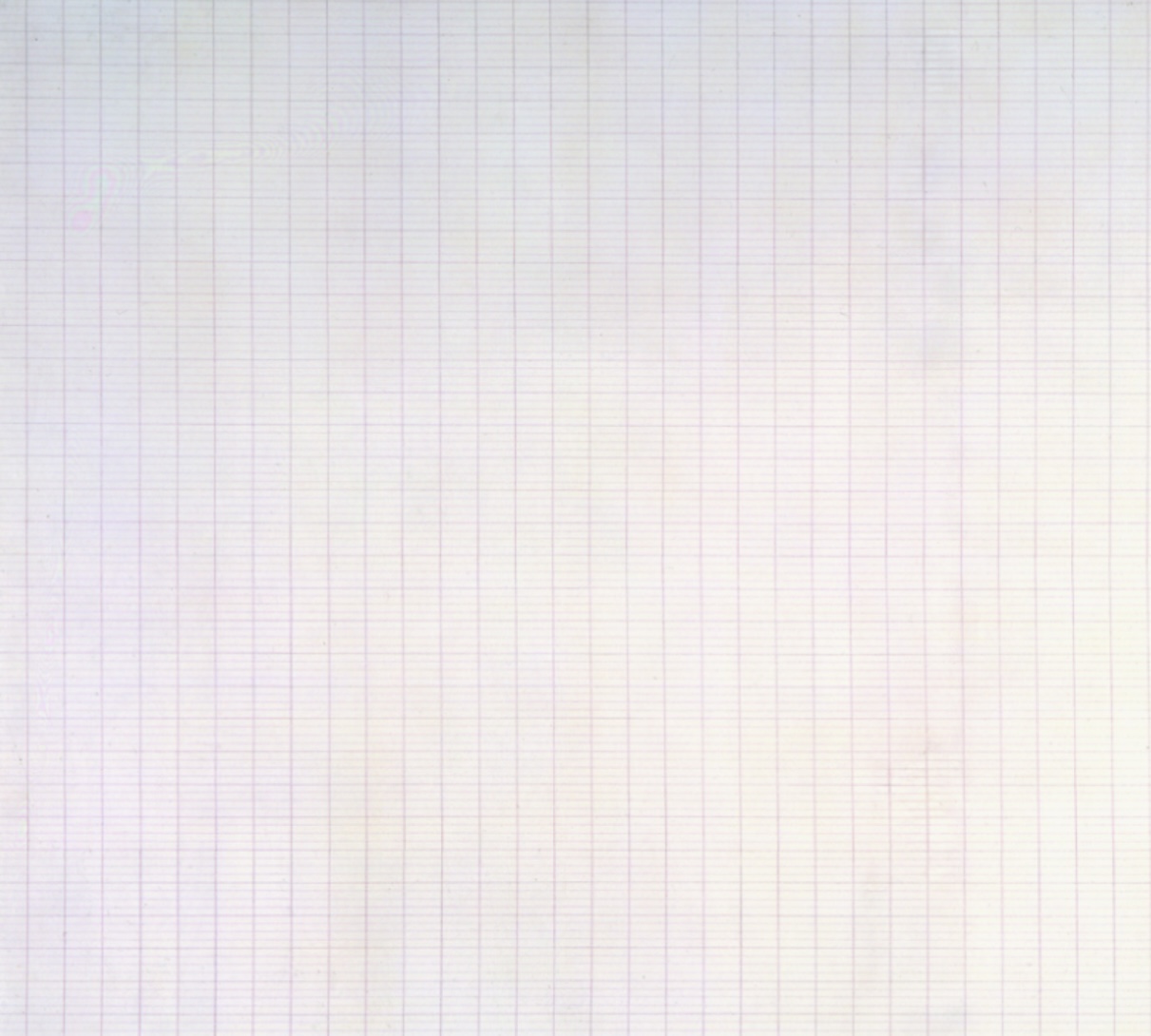
Agnes Martin
Morning
1965
Acrylic paint and graphite on canvas
Martin created rigorously structures non-representational paintings that predicted Minimalism’s popularity. Martin longed to express emotion and a transcendent reality through her abstractions.
Her signature art style was based on repetitive linear marks arranged in tight grids on blank canvases.
What is this artwork:
The light grey background is covered by a grid of dark graphite squares, each square vertically traversed by four delicate red pencil lines, creating a non-hierarchical field.
The grid itself represents perfection and a transcendent reality - the grids themselves weren’t perfect, as they consisted of hand drawn lines varying in length and weight. The work is a human perception of perfection, and the canvas invites the viewer to mediate in the expression of the sublime.

Frank Lloyd Wright
Kaufman House (Fallingwater)
1934-37
Located in Bear Run, PA
In the later years of his career, Wright was committed to the organic ideal of unity between his buildings, the furnishings and the site it’s created on
Wright was commissioned this house to be a summer home for the Kaufman family, and is located directly on top of a river known as Bear Run.
The building’s horizontal jutted layers (re-enforced concrete anchored to the river rock) hover dramatically over the stream. Wright eliminated walls in favor of glass windows, opening up the house to natural light and wide views. The large open ground-floor living room has a floor mimicking the wet stream bed rocks.
Fusing a dwelling space with nature, Wright succeeds in creating organic architecture (International elements are still present - such as long windows, horizontal concrete balconies).

Le Courbusier
Villa Savoye
1928-30
Poissy, France
THE INTERNATIONAL STYLE:
Post-war modern architects wanted to inspire a new style for the new era, opposing historicism and drawing inspiration from engineering and technology as expressions of the modern machine age spirit.
Embraced rationalism and functionalism - employed concepts seen in Constructivism, De Stijl, and Cubism.
What is the artwork:
Le Courbusier’s main goals: the provision of functional efficiency, and the creation of beauty through refined arrangements of abstract formal elements and spaces.
Villa Savoye illustrates his five points of new architecture: 1) support of the building through columns lifting the first floor, 2) the incorporation of a flat roof, 3) a free interior plan, 4) the use of long horizontal windows, and 5) curtain walls.
The Villa appears as a elegant embodiment of Purist ideals, as its “a box raised above the ground”. It adapts classical values with modern functionality in theory, but in reality the formation led to many failings (a flat roof leaks all the time, the large spanning windows do not keep cool or warm air).
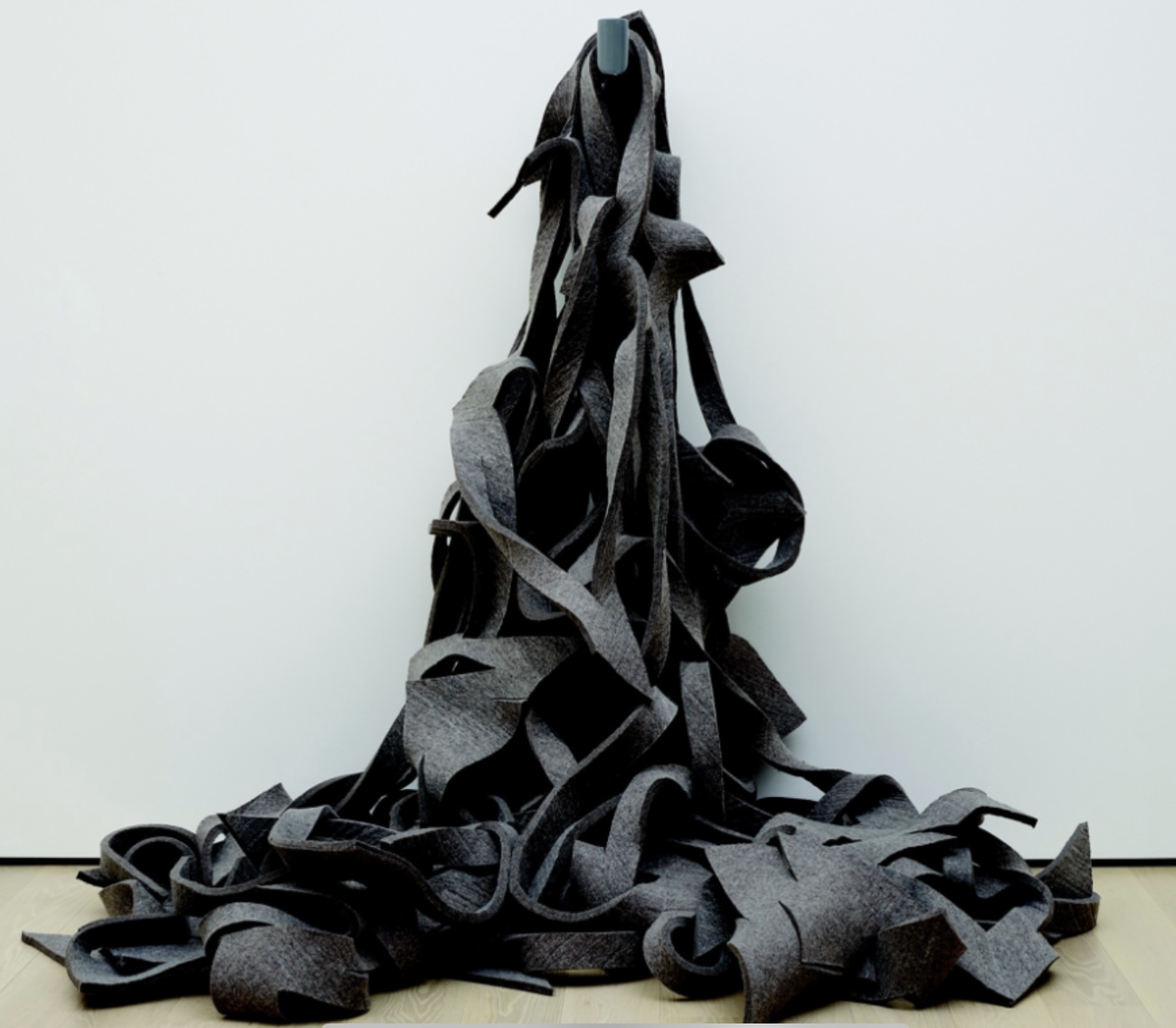
Robert Morris
Untitled (Tangle)
1967
Felt
POST-MINIMALISM:
Post-minimalism is an umbrella term that encompasses process art, conceptual art, land art, and body art. Post-minimal art accepts Minimalism’s direct, reductive character, but allowed references to ideas and concerns beyond the physical and visual.
Conceptual artists downplayed the physical object to emphasize ideas, Body artists used their body as a medium to convey ideas, while Land artists transported natural materials/worked directly in landscapes.
What is this artwork:
PROCESS ART: Refers to art which the procedures and materials used to make the work are given prominence in the finished product. This gives it a narrative component, relating to a sequence of events.
Morris focused on “Anti Form” - advocating to move beyond the fixed, rectangular forms of Minimalism to investigate flexible materials shaped by chance and gravity.
Turned to soft grey industrial felt to create works like Tangle, where a large felt sheet is cut to create long rectangular strips and them hung from a peg on the wall.
Lacking a fixed structure and revealing the process of its creation through its response to gravity, the sculpture appears different each time it is installed.

Eva Hesse
Contingent
1969
Cheesecloth, latex, fiberglass
Hesse began working with rubber and fiberglass, leaning into creating organic forms. She would repeat these organic forms, transforming Minimalism’s use of repetition of identical machine fabricated units into repeated hand-made forms that are similar but distinct.
Contingent comprises of eight loosely rectangular pieces of rubberized cheesecloth embedded in fiberglass panels. It is suspended from the ceiling, allowing it to sag in response to gravity.
Though it occupies space like a sculpture, it’s flat and incorporate expanses of cloth, like painting. The panels hang in a orderly row, with each having a different size or appearance.
Rather than being hard and shiny like Minimalist pieces, this artwork projects human qualities of fragility and aging (as the latex rubber would turn brittle and discolor over time), giving the artwork a sense of mortality.
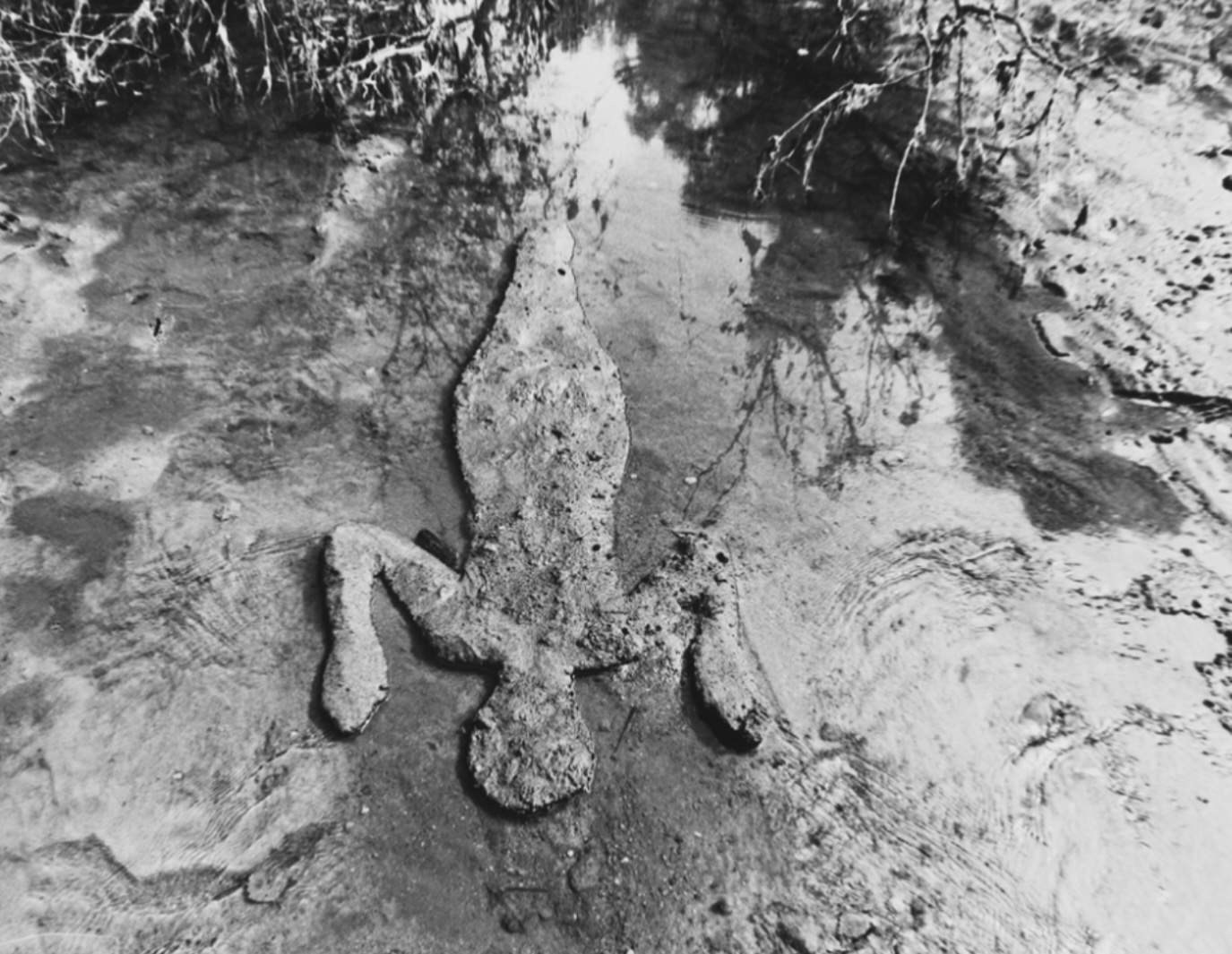
Anna Mendieta
Silueta de Arena
1978
Black and white photograph
BODIES AND FEMINIST ART:
Perception of the “gaze”, which refers to the visual perception that brings joy and exerts power over the perceived object, led Feminists to recognize much media was formed through a white, male, heterosexual gaze.
Feminist artists aimed to reclaim the female body as a subject and assert a women’s right to control and enjoy their bodies and sexuality.
What is this artwork:
Combining land and body art, Mendieta made over 200 silhouettes using natural materials shaped as the artist’s body, with her arms upraised.
These would be imprinted on the ground, sculpted above the ground, or placed against a wall. Mendieta documented these site-specific artworks through film and photography.
Many of these artworks were made in Iowa, where she lived after her parents sent her there away from Cuba due to political persecution. She show her artwork was motivated by having been torn away from her homeland, with her art re-connecting her bonds with the natural universe/the maternal source.

Robert Smithson
Spiral Jetty
1969-70
Black rock, salt crystal and earth
LAND ART:
Where the artist directly interacts with the land and natural environment to produce a permanent or temporary site-specific artwork. Alternatively, the artist can also move materials to a gallery to be used. Land art shares Minimalism’s commitment to declaring the reality of the materials from which the work is made of.
What is this artwork:
Smithson was interested in the concept of “entropy”, a term in physics that describes a system’s devolution into disorder and undifferentiated sameness - he sought to capture this chaos in his art.
Spiral Jetty was made on the shore of Utah’s Great Salt Lake, a location chosen for his algae covered pinkish/red water. With help from a sponsor, he hired construction equipment to construct a fifteen-feet wide rock and dirt path extending 1,500 feet into the shallow water and coiling in to a counterclockwise spiral.
The spiral evokes many different themes or images: such as a spiral nebulae in outer space, the spiral structure of salt crystals present in the lake, or the 18th century myth stating that the Salt Lake had a whirlpool in its center. The reddish water suggests blood, which stands as the liquid origins of life.
Spiral Jetty is always effected by changes, as its disappeared due to rising water levels, then re-appeared after water levels dropped. Unless preserved, it will eventually cease to exist, makign it subject to entropy.
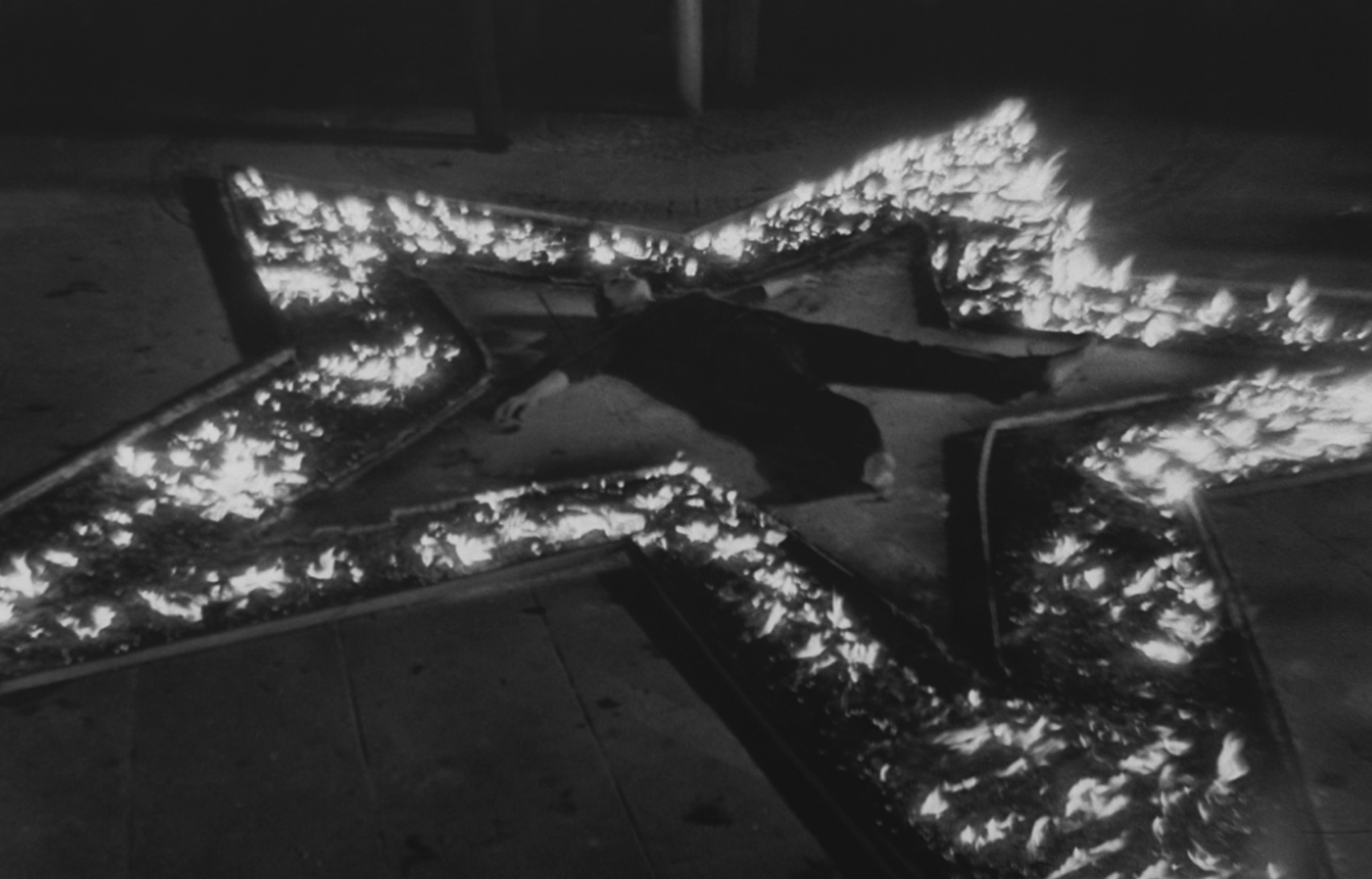
Marina Abramović
Rhythm 5
1974
Performance Art
In her Rhythm series of performances, Abramović put herself in risky situations that highlighted the issue of control, figuratively resisting or questioning the government’s imposition of control on its citizens in her native country of Yugoslavia.
In this artwork, Abramović laid out strips of wood shaped like a star (the symbol of the Yugoslavian government), filled it with wood shaving and petrol, lit, threw her hair and nails into the flames, and then lay down in the star’s center with outstretched limbs.
Her act symbolized the younger generation burning in the flames of the older generation’s socialist ideals. The fire took away her oxygen, causing her to pass out and be rescued by two of her colleagues.
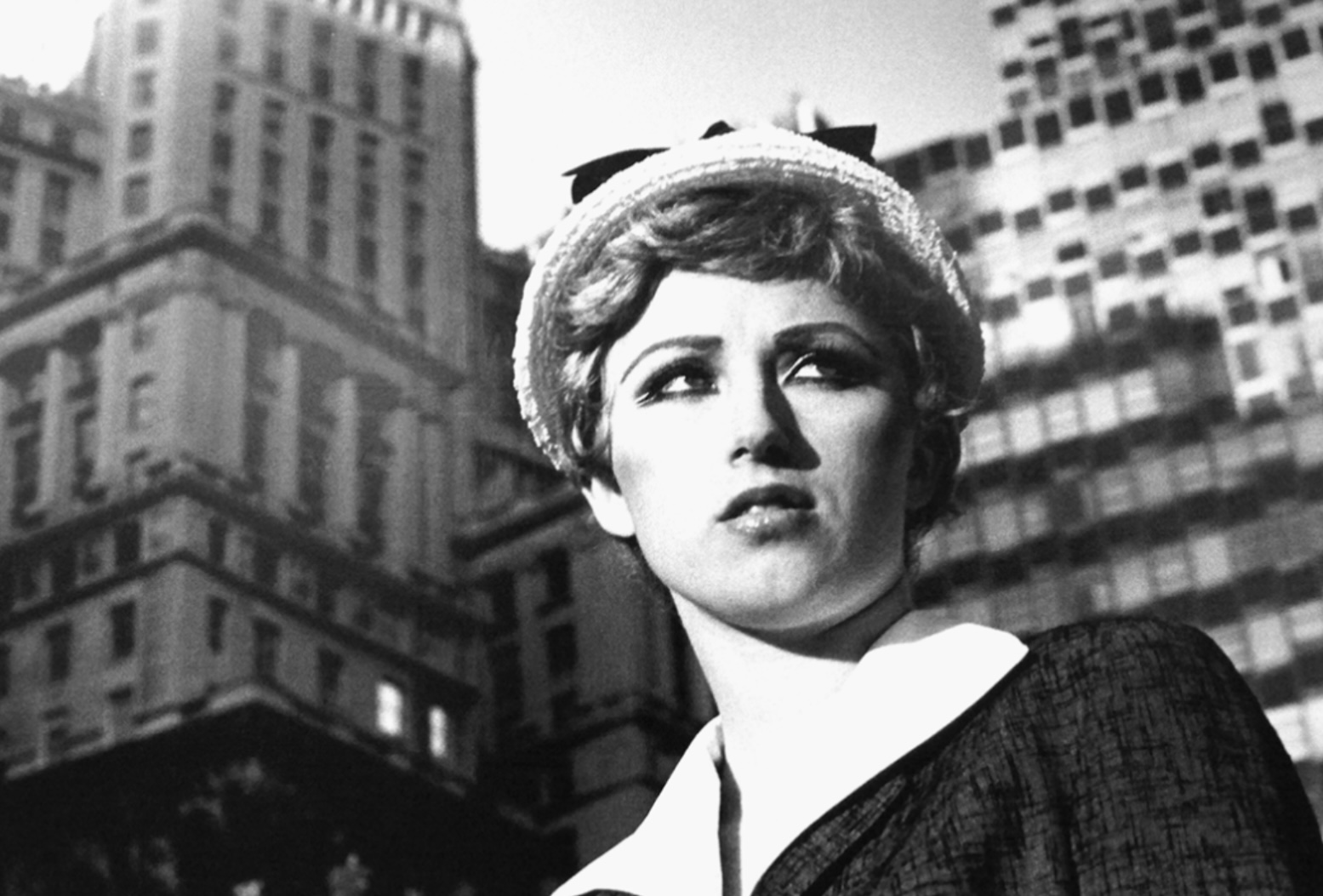
Cindy Sherman
Untitled Film Still No. 21
1978
Sherman poses for the camera herself and appropriates stylistic devices from film, television, advertising, fashion, and popular culture rather than quoting specific well-known images.
Sherman would transform her appearance through makeup, wigs, costumes, costume makeup, and digital manipulation. Her subject wasn’t ever herself, but instead the ways in which the female self is construction and presented in the visual culture.
In her film stills, she would dress up as old Hollywood actresses, and even present her photographs in the traditional film still size. She never imitated characters, instead making her own narratives withheld from the viewer, who can only guess the context.
In this still, she’s a professionally dressed young woman looking anxious amongst the busy city. Her continually shifting presentations of womanhood emphasized the idea of gender as performance - a manipulation of social and cultural codes rather than a essential thing.
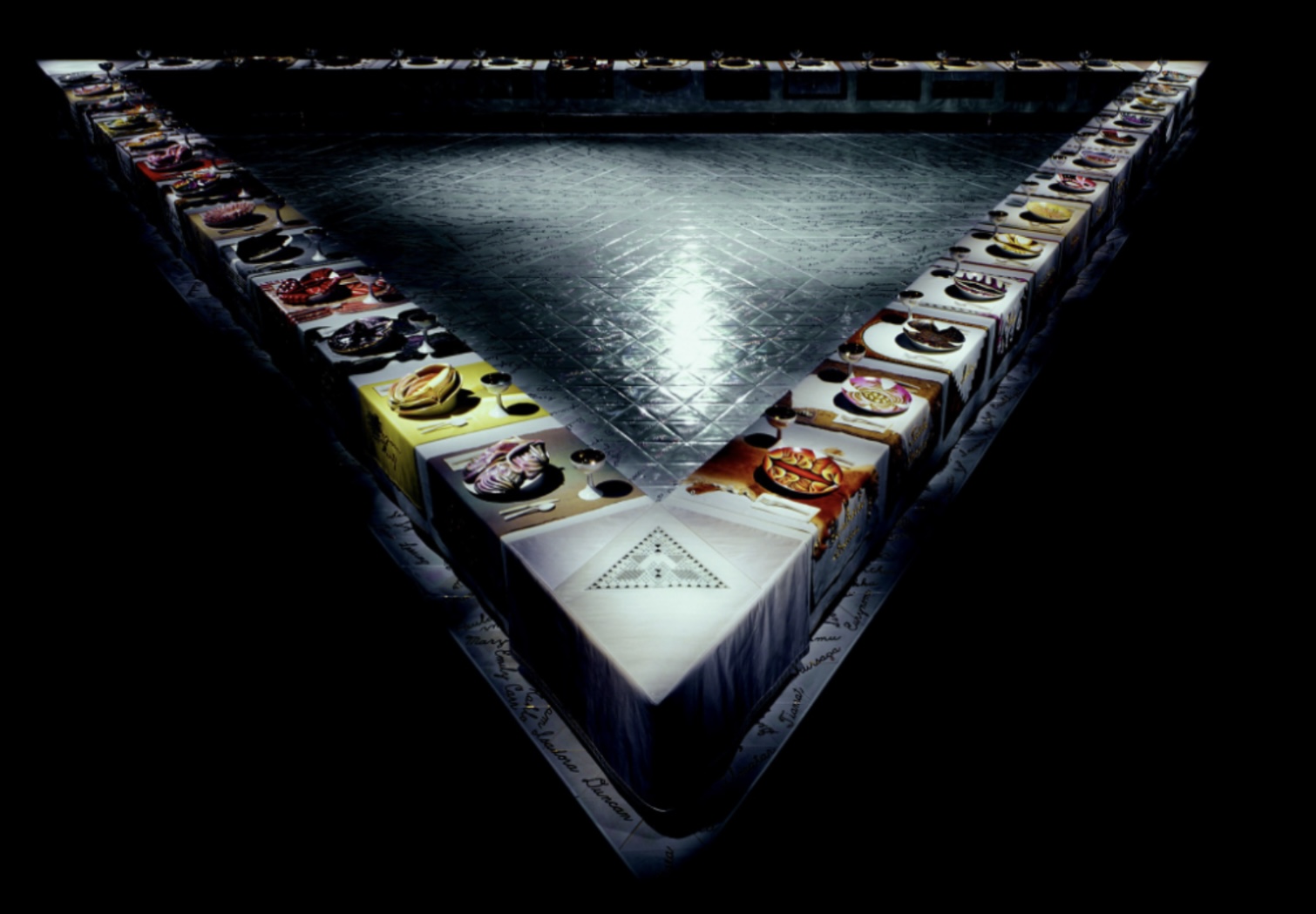
Judy Chicago
The Diner Party
1974-79
Judy Chicago spend six year creating this artwork, wanting it to symbolize the history of women in Western Civilization. Hundred of women (and a few men) toiled on this project under Chicago’s direction.
The composition comprises of an open triangular table with 39 table setting dedicated to women ranging from ancient goddesses, to historical figures (Susan B. Anthony, Judith from the Bible). Underneath the table is a while porcelain floor engraved with the names of another 999 women of accomplishment. The thirteen dinner settings per side reflected Chicago’s initial conception of the artwork as a play on the all-male Last Supper.
The equilateral triangle, the ancient symbol of the female, expresses feminism’s goal of an equalized world. Each place setting has a painted ceramic plate and a runner embroidered with the name of the honored woman - this celebrated crafts traditionally practiced by women. All but two plates feature stylized designs based on the human vulva, imagery used to reclaim the vagina into a vehicle asserting the beauty of the female identity.
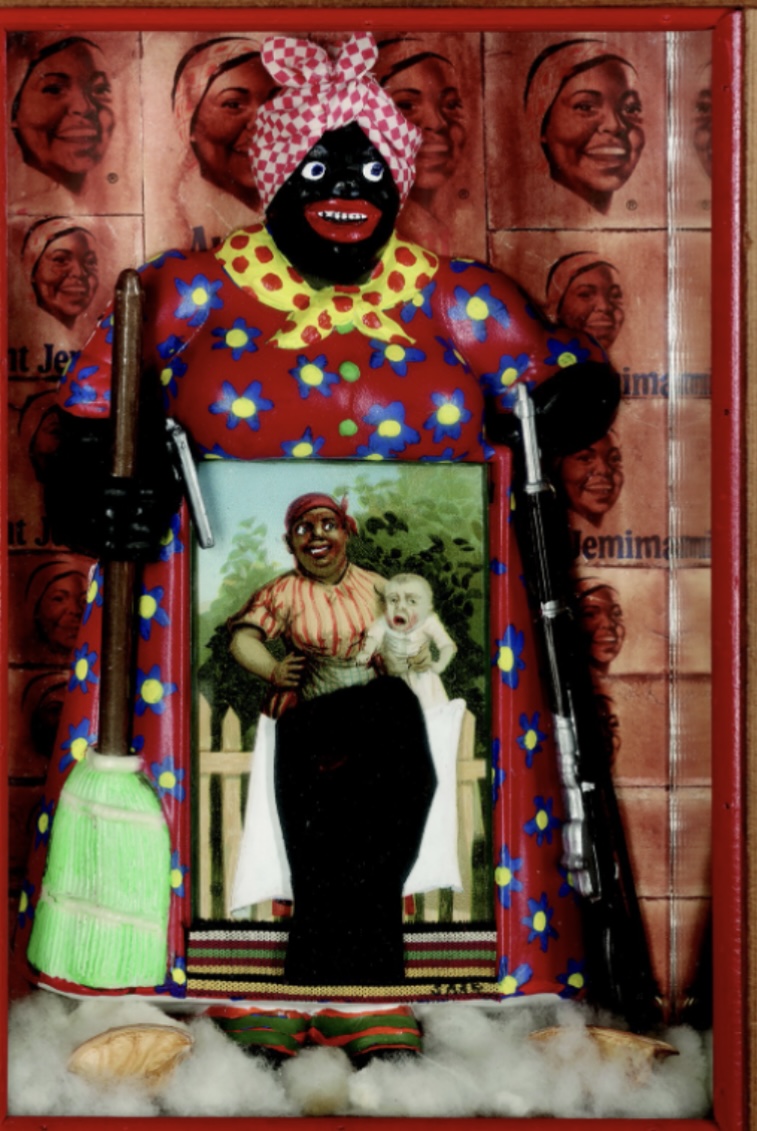
Betye Saar
The Liberation of Aunt Jemima
1972
Inspired by shadow boxes, Saar began assembling found objects in glass fronted boxes to create her assemblage artworks. Saar created political artworks incorporating derogatory commercial images of Black Americans. She wanted to emphasize the dehumanization present in these images and focus on the struggle of Black Americans before and after slavery.
In this artwork, Saar transforms the demeaning stereotype of the cheerfully servile “mammy” into an icon of black feminine militant power. Set against a background of repeated Aunt Jemima advertising images, stands a caricatured mammy figure holding a broom and a toy pistol and rifle. She’s meant to hold a notepad in her core, but instead there’s an image of a jolly mammy holding a crying white baby.
In front of this image is a clenched black fist which symbolizes Black power. Saar’s Jemima is empowered to not only liberate herself from racial oppression, but also from traditional gender roles that forced Black women into subservient occupations.

Barbara Kruger
Untitled (Your Gaze Hits the Side of My Face)
1981
Photograph
Kruger was known for her large photographs using appropriated black and white photographic sources, overlaid with her own text, and framed in bright red strips
Kruger gave her works the visually arresting look of advertisements. Unlike advertisements, Kruger’s works rebel against capitalist desire and challenge stereotypes and expose power under patriarchy.
This artwork suggests the heterosexual male gaze’s objectification of the female body through the image of a classical style feminine bust. Kruger’s texts imposed upon her photos use plural and personal pronouns to identify the speaker, inviting the viewer to explore perspectives.
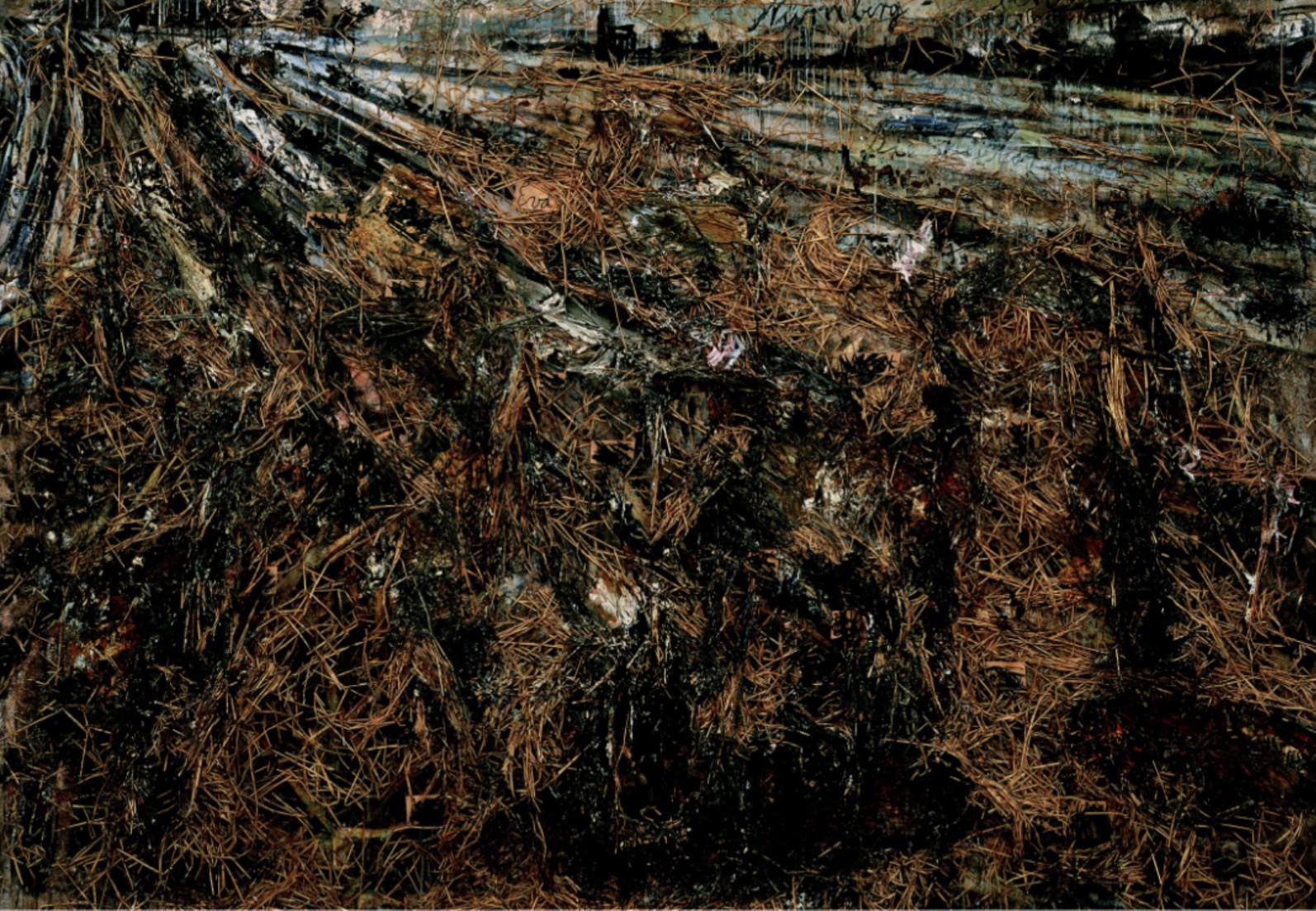
Anselm Keifer
Nurnberg
1982
Oil, acrylic, emulsion, and straw on canvas
Most of his artworks are created on a massive scale, being decorated with paint alongside organic materials like straw, shells, or ashes. Keifer explored subjects of Nazism and German political/historical history. His art invoked grandiose Nordic, Neoclassical, and German Romantic themes - reflecting on the Nazi usage of these art movements in their propaganda.
This artwork depicts a historically significant city as scarred and desolate in the aftermath of war. Nuremburg was a hub of the arts during the 16th century, but later was a site of Nazi rallies and the postwar trials of Nazi criminals. A vast straw filled field converges into a vanishing point. Silhouetted buildings situate the building as the Nazi party rally grounds southeast of the city. Many words are inscribed on the painting, such as the name “Eva” which calls back to the main character from a German opera. Nazi’s appropriated this opera’s music for propaganda purposes, which deepens the meaning of Keifer’s reference. The work overall acknowledges and reflects the history’s weight and complication.

Kara Walker,
detail of “Slavery! Slavery”
Is a provocative, large-scale installation that uses cut-paper silhouettes to explore the brutal history of slavery in the American South.
Composed of black paper silhouettes against a white background, depicting grotesque and surreal scenes drawn from antebellum Southern life. The piece engages with themes of racial violence, power, sexuality, and historical memory.
The piece is intentionally ambiguous and uncomfortable, blurring the line between victim and perpetrator, fact and fantasy. It forces the viewer to grapple with how histories of racism are remembered, mythologized, or ignored.